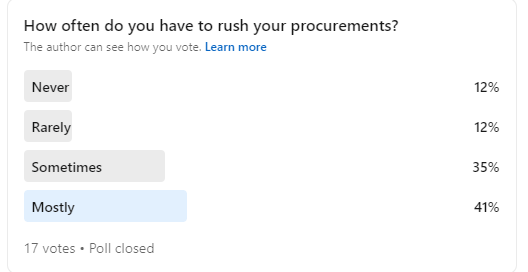Do you get enough time to run your procurements…?
Rushed procurements are obviously a problem, but how rare are they?
To find out the answer, we recently asked the network on LinkedIn: how often do you have to rush your procurements?
The results are for you to see below…
Of the 17 people who voted, 41% and 35% voted for ‘mostly’ and ‘sometimes’ respectively. Interestingly, only 12% said that they ‘never’ rushed their procurements.
Although we appreciate that it is a small sample size, it does suggest rushed procurements in major programmes aren’t rare at all. In fact, they are actually rather common!
In this blog post, I will explore why procurements are rushed and the impact it incurs on major programmes. I will also share my advice on what you can do about it.
Which procurement professionals are we referring to?
The term ‘procurement professional’ is broad and encompasses anyone who acquires goods, services, or works from an external source, often via a tendering or competitive bidding process.
However, the scope of procurement professionals referred to here are those supporting Digital Transformation programmes – procuring services such as systems integration, technology, and client-side managed service provider, etc.
Why is procurement rushed?
In our experience, there are three key reasons why procurement is rushed.
1) Although procurement is necessary for the programme to achieve its aims and objectives, it isn’t valued highly by non-procurement professionals. In fact, it is often seen as a means to an end.
2) More often than not, procurement is on the critical path. In case you were unaware, this is the longest sequence of activities from project start to finish that must be completed to ensure the project is finished by a certain time.
If work can’t start until the procurement is complete, then it is likely to be rushed. This is because (as mentioned above) procurement is often viewed by non-procurement professionals as a means to an end.
3) Whilst not usual (and certainly not allowable under procurement regulations), before the procurement commences there can be stakeholders who have a view on the right supplier for the work. Therefore, all of the procurement time can come across as unnecessary.
We believe that the Procurement profession needs a facelift. Find out more in in our blog post, 4 Ways to Change the Perception of the Procurement Profession.
How should you deal with a request to rush a procurement?
If you are faced with a request to rush a procurement, you need to resist pleas for a rushed procurement. Whilst there will always be compelling reasons for rushing a procurement, the procurement professional must remind his / her stakeholders of the purpose of procurement: value for money – which is best achieved through a competitive bidding process.
A rushed procurement may mean ineffective competition for weak suppliers, less time for suppliers to make attractive proposals, and less time for the organisation to firm up its requirements & think about ideal qualities of the winning bidder.
What is the impact of a rushed procurement?
We intrinsically believe that rushing a procurement is wrong because of the impact it incurs on major programmes. Here are the potential worst-case outcomes…
Bad outcome: A bad outcome is that the wrong supplier will be selected.
Very Bad outcome: A very bad outcome is that the wrong supplier will be selected on incomplete specifications.
Worst outcome: The worst outcome is that a rushed procurement will result in a failed programme, and a fresh procurement will be need.
Think how much wasted time and money this will cost the programme!
The only beneficiaries of a failed programme are people who work on the programme; those who earned wages and fees for the work at the cost of the programme sponsor.
Advantages of a procurement that runs for the time it needs
If you want to run a successful programme you shouldn’t rush a procurement. Below, we have listed the advantages of running a procurement for the time it needs.
1) As the business case for the procurement is shaped, it allows for a full appraisal of the need for the services and the alternative options for delivery (inhouse, mixed models, etc.).
2) Running a procurement for the time it needs ensures that there is proper quality evaluation of the bidders on parameters other than price.
3) There are fewer unknown unknowns in the eventual contract. This will help limit change requests, and protects future spend.
In our Government Procurement Guide, we explore how you can select a route-to-market strategy so you get the best procurement outcomes.
When is rushing a procurement justified?
Although we are against rushing a procurement, there are certain situations where it can sometimes be justified.
1) If the procurement is low value:
Procurement should always be proportionate. The effort for purchasing stationery worth £5,000 is very different to purchase ERP worth £15m.
2) Unforeseeable procurement with severe consequences of delay:
In the case of the COVID-19 pandemic, rushed procurements were justified because it helped save lives.
What if in procurement’s view the changes were foreseeable?
Honestly, this is where procurement should still focus on the consequences, and in slower time ensure that the business has developed controls to avoid recurrence of this instance in the future.
Can shortcuts can be used?
Rather than rushing a procurement, certain shortcuts can be used to speed up the procurement process. By taking the right shortcuts, businesses can improve the efficiency of programmes while ensuring quality remains intact.
We have identified five specific shortcuts you could take during the procurement process – without affecting the quality of the programme.
1) Written Procurement Feedback
It can be more effective to provide feedback in writing (rather than organising a meeting), both for business purposes and for the supplier.
2) Programme Administrative Resources
An effective way to save time is to use the programme management office to deal with any administrative needs within Commercial.
3) Introduce a Procurement Checklist
You can incorporate a checklist into your approach. You can then check off the items, you are interested in. This includes indemnity provisions, termination notice lengths and price restraints, etc.
4) Reduce Analysis Work
Eliminate one stage of the analysis process and make sure every supplier who submits a proposal will also present the information.
5) Limit Responses
When asking suppliers to respond to your requirements, have a template or make sure their responses are limited in the word count.
We explore each of these points in more detail in our blog post, Are Shortcuts Possible in Procurement?
Where do you go from here?
Although rushed procurements often result in a negative outcome, they are still prevalent in digital transformation programmes.
Moving forward, organisations must run a procurement for the time it needs to take advantage of the numerous business benefits.
If you are a Programme Director, you may also be interested in our Commercial Matters podcast.
This podcast is for leaders of major transformation programmes looking to confidently tackle niggling supplier relationship issues in their IT programmes.
Alternatively, feel free to follow us on LinkedIn to get first sight of our new blog articles.


